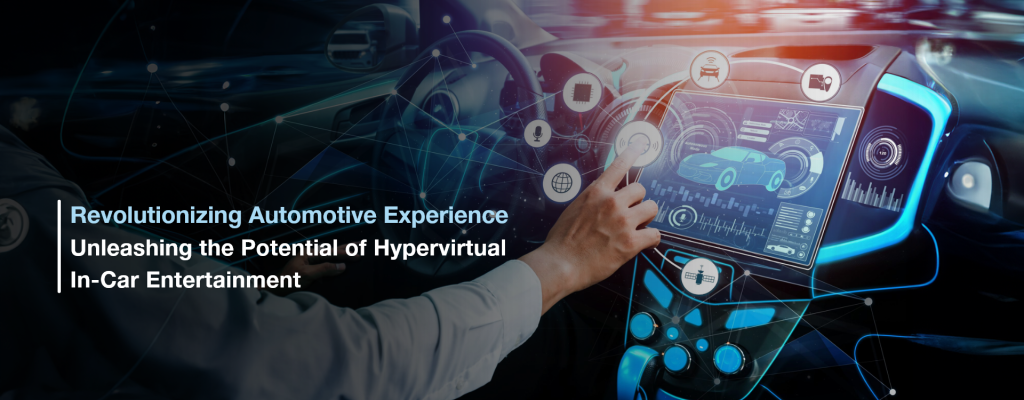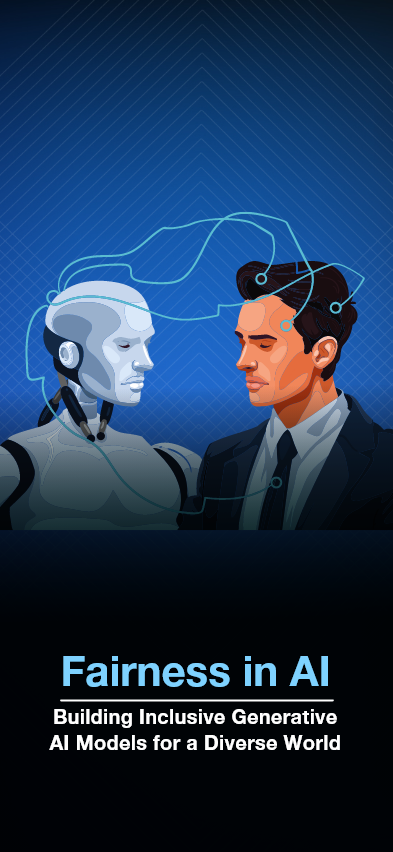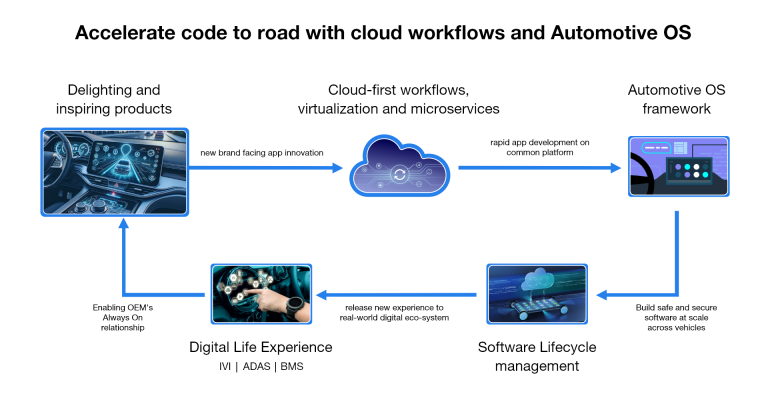

The automotive industry has witnessed significant advancements in recent years, especially in the realm of in-car entertainment. One of the latest and most promising developments in this field is hyper- virtualization. Hyper-virtualization refers to the use of virtual reality and augmented reality technologies to create immersive and interactive experiences within the car. By integrating hyper-virtualization into in-car entertainment systems, automakers are revolutionizing the driving experience.
Hyper-virtualization in car entertainment allows passengers to escape the confines of their vehicles and embark on virtual journeys. With the help of virtual reality headsets and augmented reality displays, passengers can explore virtual landscapes, visit historical landmarks, or even travel to distant galaxies, all from the comfort of their car. This technology opens up a whole new world of possibilities for entertainment during long drives, making them more enjoyable and engaging.
Moreover, hyper-virtualization can also transform mundane daily commutes into exciting and educational experiences. Imagine sitting in your car while your dashboard displays virtual information about the places you pass by, such as historical facts or interesting trivia. This integration of virtual elements into the real-world environment can make your daily commute more entertaining and enriching.

One of the key aspects of hyper-virtualization in automotive entertainment is dashboard virtualization. Traditional car dashboards are being transformed into digital interfaces offering many functionalities and customizations. With the help of advanced sensors and display technologies, automakers are creating interactive dashboards that provide a seamless user experience.
Dashboard virtualization lets you personalize your driving experience like never before. You can customize your dashboard’s layout, rearrange widgets, and choose the information you want to see. Want to see your favorite social media feeds or check the latest news headlines while driving? With dashboard virtualization, it’s possible. You can even integrate your smartphone seamlessly with the dashboard, allowing you to access your favorite apps and media directly from the car’s interface.
In addition to customization, dashboard virtualization also enhances safety and convenience on the road. For example, with augmented reality overlays, important information like navigation directions or upcoming road hazards can be displayed directly on the windshield, eliminating the need to look away from the road. This technology keeps your focus on driving while providing you with crucial information in real-time.
The integration of artificial intelligence (AI) and the Internet of Things (IoT) has been pivotal in revolutionizing automotive infotainment systems. AI-powered voice assistants, such as Amazon Alexa or Google Assistant, are now becoming common features in cars. These voice assistants allow you to control various aspects of your in-car entertainment system using natural language commands. You can ask them to play your favorite music, change the temperature, or even find nearby restaurants, all without taking your hands off the wheel.
Furthermore, the IoT enables seamless connectivity between your car and other smart devices. You can sync your car’s infotainment system with your smart home devices, allowing you to control your home’s lighting, temperature, or security system from your car. This integration creates a truly connected ecosystem that enhances your overall driving experience.
The combination of AI and IoT in automotive infotainment systems is not only about convenience. It also opens up new avenues for personalized entertainment. AI algorithms can learn your preferences and habits over time, curating personalized content recommendations based on your interests. Whether it’s suggesting new music or recommending podcasts, AI-powered infotainment systems can keep you engaged and entertained throughout your journey.
Machine learning plays a crucial role in hyper-virtualized car entertainment by continuously improving the user experience. Machine learning algorithms analyze user behavior and preferences, allowing the system to adapt and provide more personalized and engaging content.
For example, machine learning algorithms can analyze your music listening patterns and suggest new songs or artists that match your taste. They can also learn from your feedback, understanding which content you enjoy and which you prefer to skip. Over time, the system becomes smarter and more accurate in predicting your preferences, ensuring that you always have a tailored entertainment experience.
Machine learning also contributes to the development of advanced driver assistance systems. By analyzing real-time data from various sensors, machine learning algorithms can detect potential dangers on the road and provide warnings or even take corrective actions. This technology enhances safety while driving and ensures a smoother and more enjoyable journey.
Hyper-virtualized in-car entertainment brings numerous advantages to both drivers and passengers. Firstly, it provides a more immersive and engaging experience, making long drives feel shorter and more enjoyable. Whether you’re exploring virtual worlds or enjoying personalized content recommendations, hyper-virtualization keeps you entertained throughout your journey.
Secondly, hyper-virtualized in-car entertainment enhances safety on the road. With features like augmented reality overlays and voice-controlled interfaces, drivers can access important information without diverting their attention from driving. This technology reduces distractions and improves overall road safety.
Moreover, hyper-virtualization opens new possibilities for educational experiences while driving, click here to know about People Tech Group’s Driver Ed application. By integrating virtual information about the surroundings, drivers and passengers can learn about landmarks, historical facts, or even foreign languages. This feature makes road trips not only entertaining but also educational, turning every journey into a learning opportunity.
The future of hyper-virtualization in the automotive industry is incredibly promising. As technology continues to advance, we can expect even more immersive and interactive experiences within our cars. Virtual reality headsets might become more compact and comfortable, allowing passengers to fully immerse themselves in virtual environments. Augmented reality displays could become more sophisticated, seamlessly blending virtual elements with the real world.
Furthermore, the integration of hyper-virtualization with autonomous driving technology could transform the way we experience car entertainment. With self-driving cars becoming more prevalent, passengers will have more time to engage with hyper-virtualized content. Whether it’s watching movies or playing interactive games, the in-car entertainment system will become an essential part of the autonomous driving experience.
AI-enabled car systems are revolutionizing the driving experience by providing advanced features and functionalities. In addition to voice assistants, AI algorithms can analyze real-time data from various sensors to enhance safety and performance on the road. For example, AI algorithms can detect driver fatigue or distraction and provide alerts or take actions to mitigate potential risks.
Moreover, AI-enabled car systems can learn from the driving behavior of individual users. By analyzing data such as speed, acceleration, and braking patterns, the system can provide personalized feedback and suggestions for improving driving skills. This technology promotes safer and more efficient driving practices, benefiting both the driver and the environment.
Digital dashboards are reshaping the automotive industry by providing sleek and customizable interfaces. Traditional analog dials and gauges are being replaced by high-resolution displays that can be personalized according to individual preferences. From choosing the color scheme to rearranging widgets, digital dashboards allow drivers to create a dashboard that reflects their style and needs.
Furthermore, digital dashboards enable seamless integration with smartphones and other devices. You can access your favorite apps, receive notifications, or even mirror your smartphone screen directly on the dashboard display. This integration ensures that you can stay connected and entertained while keeping your focus on the road.
The future of automotive design lies in the convergence of technology and aesthetics. As digital dashboards become more prevalent, we can expect to see innovative designs that enhance the overall driving experience. From curved displays to holographic interfaces, the possibilities are endless.
Hyper-virtualization is transforming the automotive industry and revolutionizing the way we experience driving. From immersive virtual reality journeys to personalized content recommendations, hyper-virtualized in-car entertainment provides a myriad of advantages for both drivers and passengers. With the integration of AI, IoT, and machine learning, this technology continues to evolve and enhance the overall driving experience.
As we look towards the future, the potential of hypervirtual in-car entertainment is boundless. From compact virtual reality headsets to augmented reality overlays on windshields, advancements in technology will allow us to create even more immersive and interactive experiences within the car. The convergence of hyper-virtualization with autonomous driving technology will further redefine the concept of car entertainment, making it an essential part of the autonomous driving experience.
In conclusion, hyper-virtualized in-car entertainment is not just about entertainment; it’s about transforming the way we experience driving. With the potential to enhance safety, provide personalized experiences, and create educational opportunities, hyper-virtualization is set to revolutionize the automotive industry and unleash the true potential of in-car entertainment.
Experience the future of automotive entertainment by exploring the latest hyper-virtualization technologies in your next car purchase. Embrace the immersive and interactive experience that hyper-virtualization offers and revolutionize your driving journey. Talk to our experts for more information.
